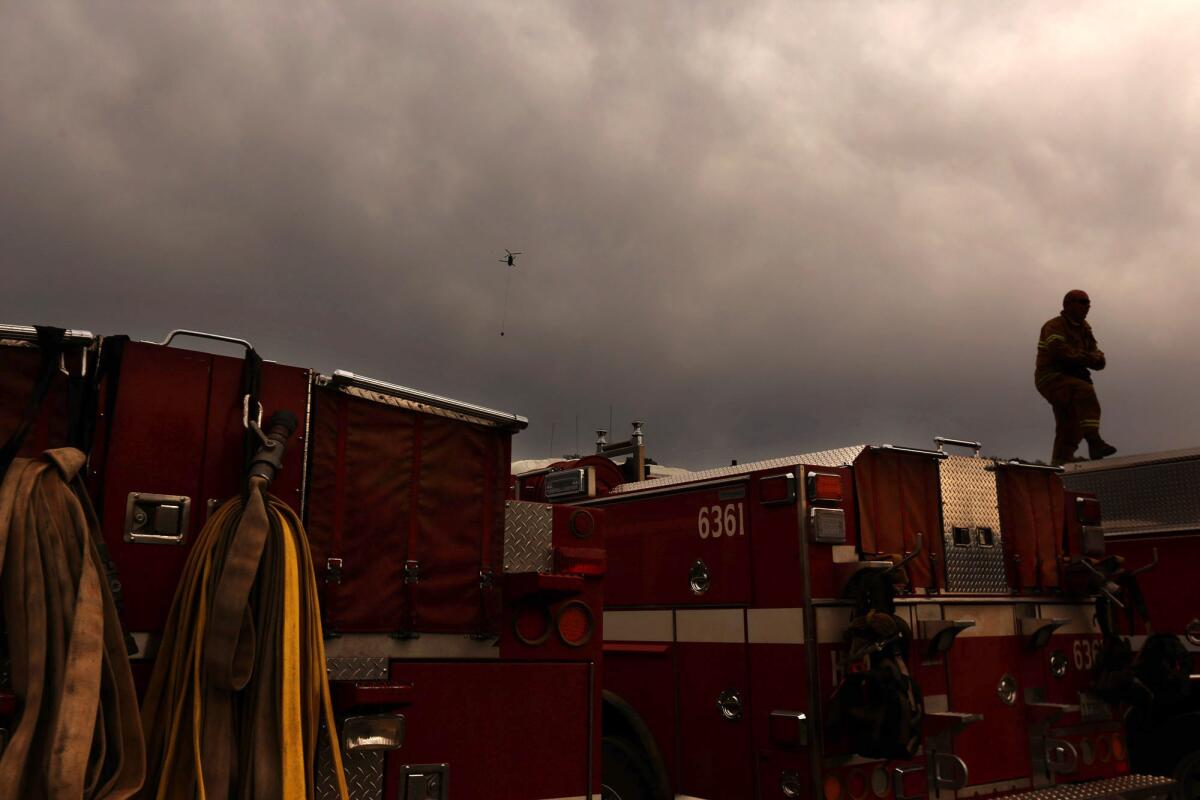Massive Rocky fire in Northern California destroys more homes

A firefighter walks on top of a fire engine as rain begins to fall in Lake County just south of Clear Lake on Tuesday.
- Share via
The number of homes destroyed by the 68,300-acre Rocky fire burning north of Napa has climbed to 39, officials said Wednesday.
Fire officials warned Wednesday that the number of structures lost may continue to increase as crews assess damage in scorched areas of the Rocky fire. So far, the California Department of Forestry and Fire Protection said raging flames have destroyed 39 homes, up from 24, and 52 outbuildings, and damaged four structures.
Meanwhile, firefighters remained vigilant as hot and dry conditions returned Wednesday, increasing the potential for extreme fire behavior.
Temperatures could hit 90 degrees in Clearlake, near where more than 3,400 firefighters are battling the 68,300-acre wildfire, according to the National Weather Service.
The temperature increase, caused by a low-pressure system, is a shift from Tuesday, when cooler weather and a light drizzle allowed firefighters to advance.
Read more about California wildfires >>
Thunderstorms are expected to return Thursday to the Sierra Nevada and coastal mountains.
Because of the Rocky fire’s unpredictability, Cal Fire officials issued a strong notice to residents Tuesday: “Stay vigilant and adhere to any changes in evacuations and road closures.”
“Fire activity and direction can change at any time, be prepared and stay informed,” Cal Fire officials said.
Thousands of people in Colusa, Lake and Yolo counties were asked to evacuate their homes during the firefight as fast-moving flames inched closer to neighborhoods.
The fire, which started July 29 near Clearlake, has plowed through containment lines, jumped over a highway and even managed to create its own weather system. Flames suck up heat, energy and moisture, then shoot those elements into the air to form a mushroom top of smoke and ash.
Every so often, that plume crashes to the ground, either because of its own weight or because of a temperature drop, which sends flames and wind rushing around it in all directions.
“This fire wants to do whatever it wants,” Cal Fire spokesman Jason Shanley said. “It’s defying all odds. Thirty-year, 40-year veterans have never seen this before.”
Bill Patzert, a climatologist with the Jet Propulsion Laboratory, said the high-pressure systems carrying hot, muggy weather and pushing winds north along the coast are colliding with a low-pressure system, resulting in higher winds. Although the drought isn’t likely to have an effect on the number of fires, the dry conditions will add to their intensity, he said.
“Once they start up, they burn hotter. They’re less controllable,” he said.
The Rocky fire, which is 20% contained, is the largest blaze burning in the state. It is one of 24 fires scorching parts of California, requiring more than 10,000 firefighters.
The rash of fires prompted Gov. Jerry Brown to declare a state of emergency last week. On Tuesday, the White House said President Obama asked his team to stay in touch with local officials as fire efforts continued.
The cause of the fire remains under investigation, but thousands of lightning strikes have ignited wildfires since last week, fire officials said.
Unfortunately, the Rocky fire and its fast-moving wind gives fire officials a preview of what could be expected in a water-starved region during the heart of fire season.
“It’s misbehaving so much,” Shanley said. “It’s just almost, I want to say obnoxious — that’s not even the correct word for it. It’s unbelievable.”
Times staff writer Corina Knoll contributed to this report.
For breaking news in California, follow @VeronicaRochaLA and @JosephSerna.
ALSO:
Woman accused of starting 14 roadside fires in Northern California is arrested
Nighttime water drops help in fight against 250-acre brush fire near Ojai
Explosive Rocky fire defies odds — and expectations
More to Read
Sign up for Essential California
The most important California stories and recommendations in your inbox every morning.
You may occasionally receive promotional content from the Los Angeles Times.















